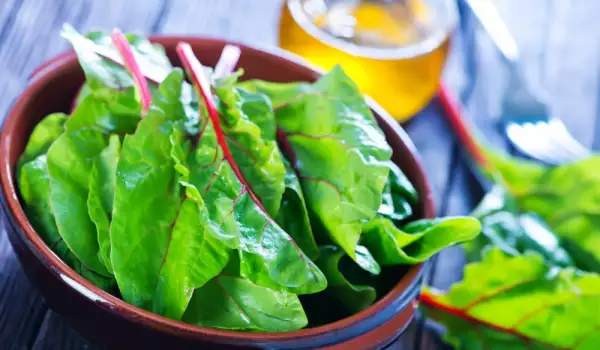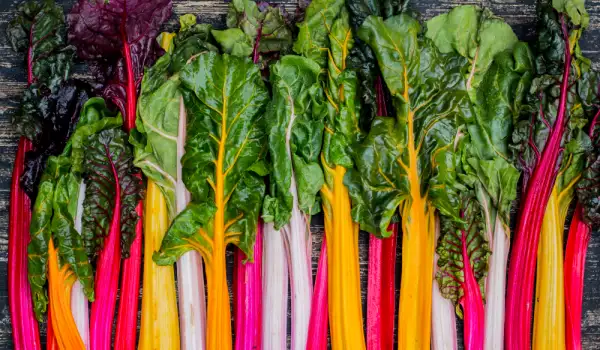Chard is a leafy vegetable, which is common in the Mediterranean cuisine. Its application in Italian food, including risotto and pizza, is particularly popular. Swiss chard is perhaps the best known, but there are varieties, including red and golden. No matter the color, this vegetable is easy to prepare and has many uses for human health.
What is chard?
Chard is also called spinach or leafy beet, but unlike beets, its roots are inedible. The green leaves have a striated texture, they are thick and dense.
What is often seen with Swiss chard is its varieties. The stems of each variety are of different colors, covering the whole range - from white to purple. White, gold and red are the most common. Whether eaten raw or cooked, Swiss chard is easy to prepare – wash, remove stems and serve.
Its taste is similar to that of spinach, but it depends on how you prepare it.
The benefits of chard
Consumption of fruit and vegetables of all kinds is associated with a reduced risk of many adverse health conditions.
Studies show that eating more plant-based foods like Swiss chard lowers the risk of obesity, diabetes, heart disease, increases energy and helps with weight loss.
Lowering blood pressure
Chard consumption has been shown to increase athletic performance. People whose diet is low in calcium, magnesium and potassium are more prone to high blood pressure.
These minerals are thought to lower blood pressure by releasing sodium from the body and helping the arteries to dilate. Taking these minerals in supplement form will not provide the same health benefits as consuming them in food.
Swiss chard contains all three of these healthy minerals and can do a lot for your health. It reduces blood, inhibits platelet aggregation and improves endothelial dysfunction.
Fighting cancer
Swiss chard contains chlorophyll, which may be effective in blocking cancer-causing heterocyclic amines generated when foods are roasted at high temperatures.
Eating leafy greens and other vegetables high in chlorophyll along with grilled meat may prevent some of the carcinogenic effects of overcooking meat.

Diabetes
Swiss chard contains an antioxidant known as alpha lipoic acid. It has been shown to lower glucose levels, increase insulin sensitivity and prevent oxidative stress-induced changes in diabetic patients.
Studies suggest that chard may also reduce symptoms of peripheral neuropathy or autonomic neuropathy in people with diabetes. It may also protect against retinopathy, damage to blood vessels.
Protects against osteoporosis
Adequate intake of vitamin K can improve bone health. Vitamin K modifies the proteins in the bone matrix, improves calcium absorption and reduces urinary calcium excretion. Low vitamin K intake is associated with a higher risk of bone fracture.
One way to increase your vitamin K intake is by eating leafy greens, such as chard, arugula and spinach.
Improves physical activity
Dietary nitrates have been shown to improve muscle oxygenation during exercise.
This suggests that higher nitrate intake may increase your physical activity and make you more durable.
The beneficial effects of nitrates on the cardiovascular system mean that it can improve the quality of life of those with cardiovascular, respiratory or metabolic diseases.
Chard is a source of vitamin K
The good news is that this green is not only quick to cook and tastes good. Swiss chard is also one of the healthiest vegetables of all. It has over 700 times the recommended daily intake of vitamin K (helps bones accumulate calcium and blood to coagulate) and 200 times the recommended daily intake of vitamin A (good for vision and immune system).
Supports the circulatory system:
Swiss chard is an excellent source of iron, which is vital for maintaining a healthy circulatory system. Vitamin K is key to healthy blood clotting and preventing bleeding. It is found in Swiss chard in significant amounts.
Blood sugar regulation
Chard contains fiber and syringic acid, which are involved in regulating blood sugar levels by changing the rate at which sugar is absorbed into the blood from the intestines.
Improves brain health

In addition to strengthening bones, the vitamin K present in Swiss chard is crucial for the proper functioning of the brain and nervous system, as it is essential for the formation of the protective layer around nerves called the myelin sheath.
Has antioxidant properties
Chard is one of the most antioxidant-rich foods on the planet. Contains beta-carotene, vitamin E, vitamin C, zinc, lutein and zeaxanthin, quercetin, kaempferol and many other disease-fighting compounds.
Strengthens hair
Swiss chard is rich in biotin, a vitamin that promotes hair growth and strength. Vitamins A and C also help hair follicles produce sebum, which keeps hair and skin supple.
Improves eye health
Swiss chard plants contain high amounts of lutein, an antioxidant that is essential for eye health and may delay or prevent the onset of age-related macular degeneration.
How long can chard be stored for?
The bad news is that chard does not stay fresh for long (about three days in the fridge in a perforated plastic bag) and tends to wilt if you wash it before cooking.
Cooking chard
Chard can be used in any culinary experiments in the kitchen. Remove the green part of the leaves and grate it. Stir and fry in butter, with turmeric, black pepper, grated fresh ginger and a splash of soy sauce.
Swiss chard can be used, along with pancetta, shallots and gruyere, to make a cheese omelette.
It's very good with celery - chop a few sticks of celery and fry as above before adding the Swiss chard.
You can add young leaves, uncooked, in a dietary salad.
You can cook Swiss chard in many ways - the leaves can be sliced and enjoyed raw in a salad, stewed with the stems, or boiled in a spring stew. If you like kale or lettuce, you can replace them with Swiss chard in your next delicious green salad.

Salad with Swiss chard
If you like cole slaw, you'll love this chard salad. When served with a light lemon dressing and mixed with garlic bread crumbs and Parmesan cheese, chard leaves become soft and buttery.
Products required:
1 bunch of Swiss chard
1/2 cup extra virgin olive oil
1 1/2 cups fresh bread crumbs
1 clove of garlic (crushed)
sea salt according to taste
chili flakes
1 lemon
3/4 cup of grated Parmesan (Grana Padano or Pecorino)
Wash and dry the Swiss chard and remove the stems from the leaves. Save the stems for another use. Stack several leaves on top of each other, roll them up like a cigar and cut the cigar into thin slices. Repeat until all leaves are torn. Place the leaves in a large bowl.
Heat 1/4 cup olive oil in a small skillet over medium heat. Add the bread crumbs and cook, by stirring frequently, until they become crispy and golden brown (about 5 minutes). Be careful not to burn them!
Sprinkle with the garlic, a pinch of salt and the chilli flakes and toast them for another minute, then remove them from the heat.
Squeeze the lemon into the bowl with the Swiss chard. Add a few generous pinches of salt. Stir slowly and add 1/4 cup of olive oil.
Add the parmesan. Stir well. Sprinkle the toasted bread crumbs over everything and serve immediately.
Potential Swiss Chard Risks
People taking blood thinners should stop eating foods high in vitamin K. It plays a big role in blood clotting, so it can interfere with the effectiveness of blood thinners.
It is important to remember that it is the overall way of eating that is most important for disease prevention and achieving good health.
It is better to eat a variety of foods than to concentrate on single foods as the key to good health.




















Comments